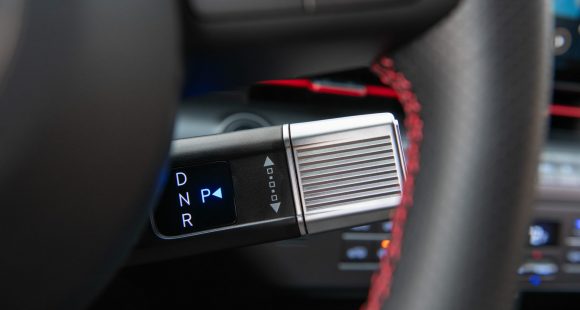2024 Hyundai Kona
Hyundai Claims More Territory On The Big Island Of SUVs
We’ve now reached the point in time where instead of integrating electric drivetrains into existing internal combustion vehicles, carmakers are engineering new platforms for electric propulsion first and then adapting them to ICE drivelines. And that’s exactly what Hyundai has done with this new Kona. So, let’s see what this approach means for this small, already appealing, SUV.
In the music industry, an artist’s second album is always the hardest. After all, they’ve had their entire lifetime to write the first one, but only a few short months to try to recreate that magic a second time around. All that to say, after being a bit of an unexpected runaway hit, the Hyundai Kona now turns to a second generation, and Hyundai is looking to avoid the sophomore slump with a bigger and better 2024 Kona.
Everything about its new interior is great and really up to date. There’s plenty of tech on display with side-by-side screens for driver info and infotainment. The 12-inch central touchscreen is standard on all Konas; the 12-inch gauge display is optional in SEL, standard in Limited and N Line, which also get Bose premium audio and a sunroof. Here in our N Line tester, the only thing that feels remotely entry-level is perhaps the front seats that some of our drivers found hard to get comfortable in.
As we mentioned at the top, the Kona was designed to be an EV first and then adapted for gasoline powertrains, so it really does have an EV vibe to it, even sharing things from Hyundai’s IONIQ EV lineup like the shifter. It also makes for more usable space inside, especially for rear seat passengers. Plus, there’s 25.5 cubic-ft. of cargo space behind, maxing out at 63.7 cubic-ft. with rear seatbacks folded.
The looks are much improved outside; same overall shape as before, but Hyundai has gone edgier, again reflecting their clean IONIQ EVs. It’s also more than 5-inches longer, with a 2.3-inch wheelbase stretch, and it sits an inch wider too. Sporty N Line gets unique front and rear fascias, along with body-color cladding, big rear spoiler, dual exhaust tips, 19-inch alloy wheels, and unique badging.
The N Line also comes with the top internal combustion engine; Hyundai’s familiar 1.6-liter I4 turbo with 190-horsepower and 195 lb-ft. of torque, working with an 8-speed automatic. A carryover 147-horsepower naturally aspirated 2.0-liter I4 and CVT combo is the standard, and more than adequate for most folks. All-wheel drive is available with all ICE Kona’s, at any trim level. As for EVs, the also new front-drive full battery Kona Electric is already on sale in some states, with multiple power offerings and a top range of 261 miles. We’ll test it soon.
Our current ICE Kona N Line was sporting the HTRAC all-wheel-drive setup, which we put to good use at Mason Dixon Dragway.
And, there was indeed great grip off the line, which made for drama free launches; power from the tiny turbo was a little slow to arrive, but once we got rolling it really started to pour on, taking us to 60 in 7.6-seconds. Despite that small hard-working engine, overall, powertrain operation was surprisingly quiet and smooth; perhaps a little too smooth when it comes to the transmission, as shifts were sluggish with noticeable drop off in power. Our best ¼-mile time was 15.8-seconds at 90 miles-per-hour.
The wider track and longer wheelbase definitely provided more stability in our handling course; suspension and steering were both quite firm, offering lots of feedback and quick response. While N Line is more of a trim package than a full N performance version, all-wheel drive Konas do come with a multi-link rear suspension setup, an upgrade over the standard torsion beam. We did find some understeer near the car’s limits, but we were carrying quite a bit of speed by that point, and easily able to maintain momentum. Despite a soft brake pedal with very little feedback, things were working just fine at the brake’s business end with consistent and fade-free stops of 111-feet from 60 miles-per-hour.
Government Fuel Economy Ratings with the turbo engine and all-wheel drive are 24-City, 29-Highway, and 26-Combined; we averaged a great 28.5 miles-per-gallon of Regular. But, that’s still an average Energy Impact Score; 11.4-barrels of oil annually, with 5.6-tons of CO2 emissions.
Pricing starts at $25,435 for SE trim; range topping Limited begins at $32,985, with this sporty looking N Line just below at $31,985.
If you’re not loyal to one particular brand, sifting through all the available small crossovers can be a daunting task. But, if you’re looking for something that’s roomy, tech-savvy, and more fun to drive than it should be, we’d suggest looking at the 2024 Hyundai Kona. By designing an EV chassis that’s capable of powering its way through this transitional powertrain period we’re in with a gasoline engine, Hyundai has made sure that the Kona is no one-hit wonder.
Specifications
As Tested
- Engine: 1.6-liter turbo-4
- Horsepower: 190
- 0-60 mph: 7.6-seconds
- 60-0 Braking: 111 feet (avg)
- MW Fuel Economy: 28.5 MPG (Regular)
- Transmission: 8-speed automatic
- Torque: 195 lb-ft.
- 1/4 Mile: 15.8-seconds at 90 mph
- EPA: 24 City | 29 Highway | 26 Combined


























